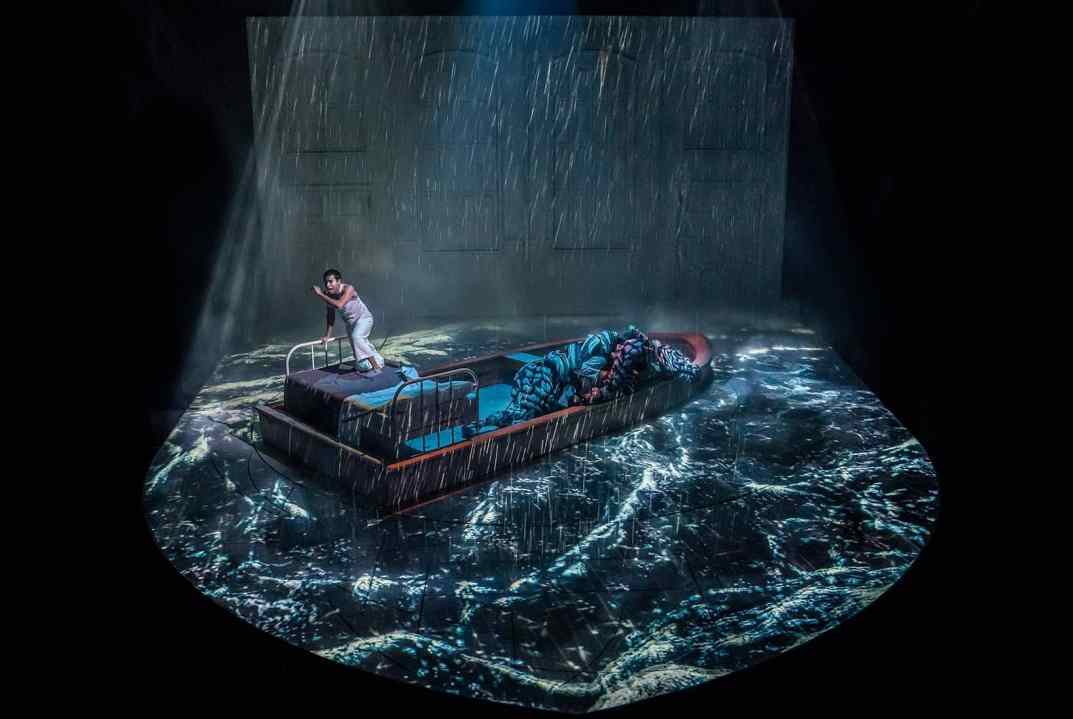Yann Martel’s novel Life of Pi is a complicated organism. The action starts in southern India where we meet a precocious teenager, Piscine, who tells his parents that he wants to be known as Pi. The family own a failing zoo and they buy a Bengal tiger to attract fresh customers. The new arrival promptly rips the head off Pi’s pet goat and eats it. Next they take a ship to Canada, with the zoo stowed in the luggage hold, but the vessel hits stormy weather. The beasts break out of their cages and start to eat each other. And when the ship sinks, Pi finds himself on a life raft alongside an orangutan, a zebra with a broken leg, and the Bengal tiger.
These spectacular scenes are tricky enough for a novelist to describe but to put them on stage seems an act of madness. How could a designer create the props and special effects required to make this sprawling and chaotic action work? Well, the miracle happened. Tim Hatley, along with puppeteers Nick Barnes and Finn Caldwell, have laid on a stunning array of models and lighting tricks. The inmates of the zoo seem to be living, breathing, sweating animals. (The larger beasts are more convincing than the smaller ones because their bulk obscures the puppeteers as they work the illusion.)
The inmates of the zoo seem to be living, breathing, sweating animals
The star is the tiger. We first see him as he prowls on stage and eyes up the unsuspecting goat. A deeply sinister encounter. Later, on the life raft, he experiences a variety of emotions. Anger, bemusement, disorientation and raging hunger. Then, after a meal of fish, he lapses into satiety and sleepfulness. These moods are so brilliantly conveyed that the tiger seems human. Pi realises that he must dominate his companion or be eaten by him so he blows a whistle and waves an oar aggressively in his face. We watch as the animal’s fear and distress move subtly towards indifference and finally capitulation. Pi wins the battle.
Later, the tiger turns into an actual human being. Pi suffers an attack of heat-stroke and has a hallucination in which the tiger appears as a drunken French sailor, sitting on a bench, legs crossed, cracking jokes. The lighting effects are dazzling too. The flat wooden stage comes alive and turns into a rippling, moving body of water. This amazing technical achievement should be seen, and marvelled at, by anyone with an interest in making stage scenery. And don’t worry about buying cheaper seats in the upper galleries. Your view of the effects may be better from on high than down in the stalls.
The acclaimed play, Straight White Men by Young Jean Lee, was the first show by a Korean-American female to be produced on Broadway. As you can see, its notoriety rests on the circumstances of the author’s birth rather than on its intrinsic merit. This is the aristocratic principle. We meet a widowed dad and his three grown-up sons as they gather for Christmas. The family dynamic feels strange. The four men spend their time eating cake, shadow-boxing, and discussing their love lives. Dad produces matching sets of pyjamas which they all dress up in. Later, they sit down to a game of ‘woke’ Monopoly in which white players lose money each time they pass Go. And their favourite pastime is to act out scenes from popular movies and musicals. This doesn’t feel like a reunion between four adult men but a sleepover party for giddy teenage girls.
The wafer-thin plot turns on the stress levels of Matt, a Harvard graduate who suffers from depression and has dropped out of life. What’s the solution? One brother suggests therapy. Another, Jake, says that depression is the right outcome for people like Matt. The problem is their skin colour, according to him, and the best option for white people is to fade away and let a member of an ethnic minority take their place. He actually says that. And he claims that the investment bank where he works refuses to promote anyone of migrant heritage. Some of his clients, Jake continues, insist on meetings involving all-white representatives. Really? Come off it.
This isn’t a satire but a wish-fulfilment fantasy in which morose Caucasians admit their sins and try to improve their behaviour. And it’s oddly racist. It sends out a message that only whites have the sophistication and the self-confidence to adjust their conduct and seek forgiveness. What about everyone else? Don’t other races misuse their wealth and power? Are they not capable of self-examination and penitence? And the cast is very pale, male and stale. The four main roles are played by white men over 40. There are two cameos for actors of colour but they don’t interact with their white counterparts. Utterly bizarre. An apartheid play that uses black performers as window dressing.








Comments